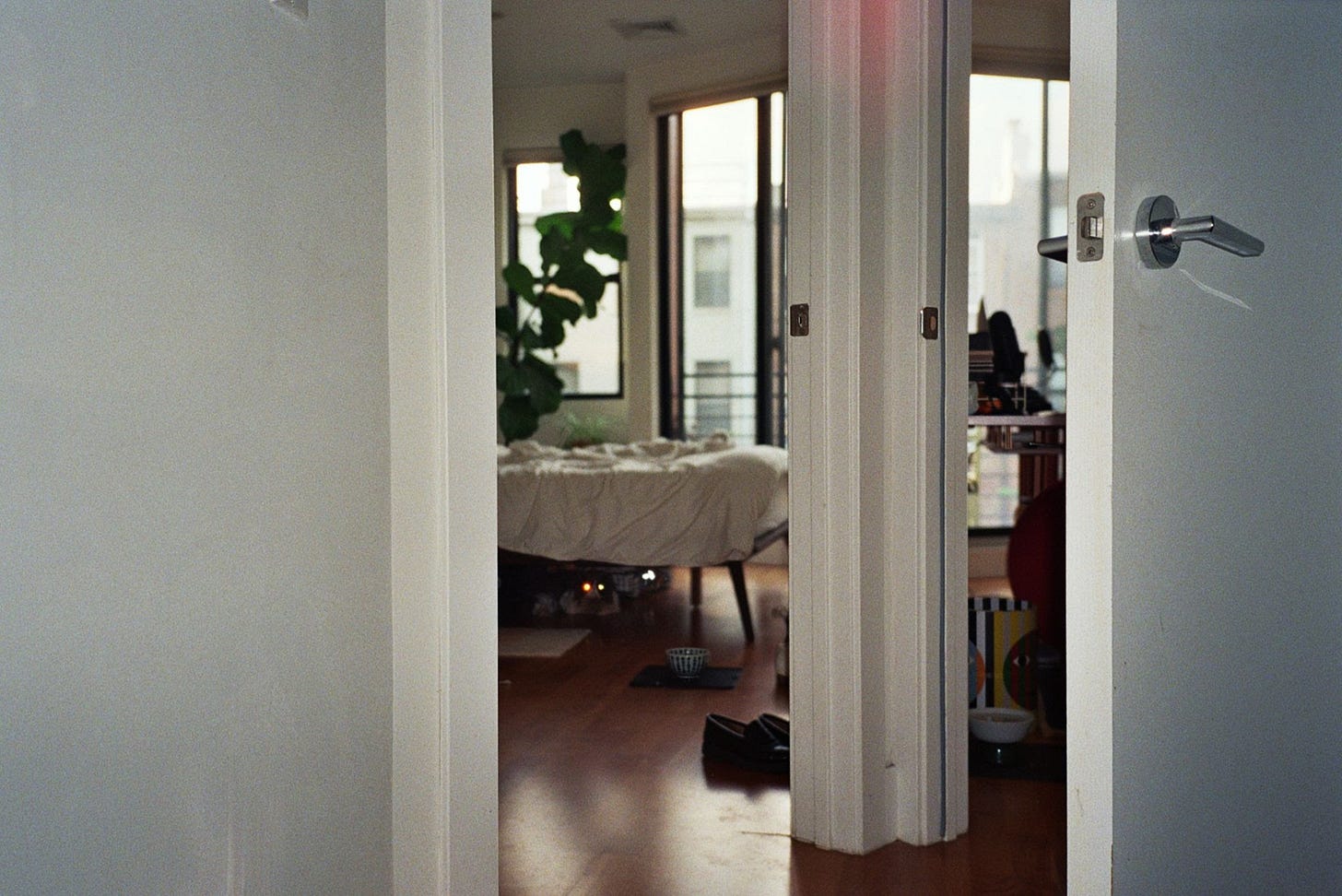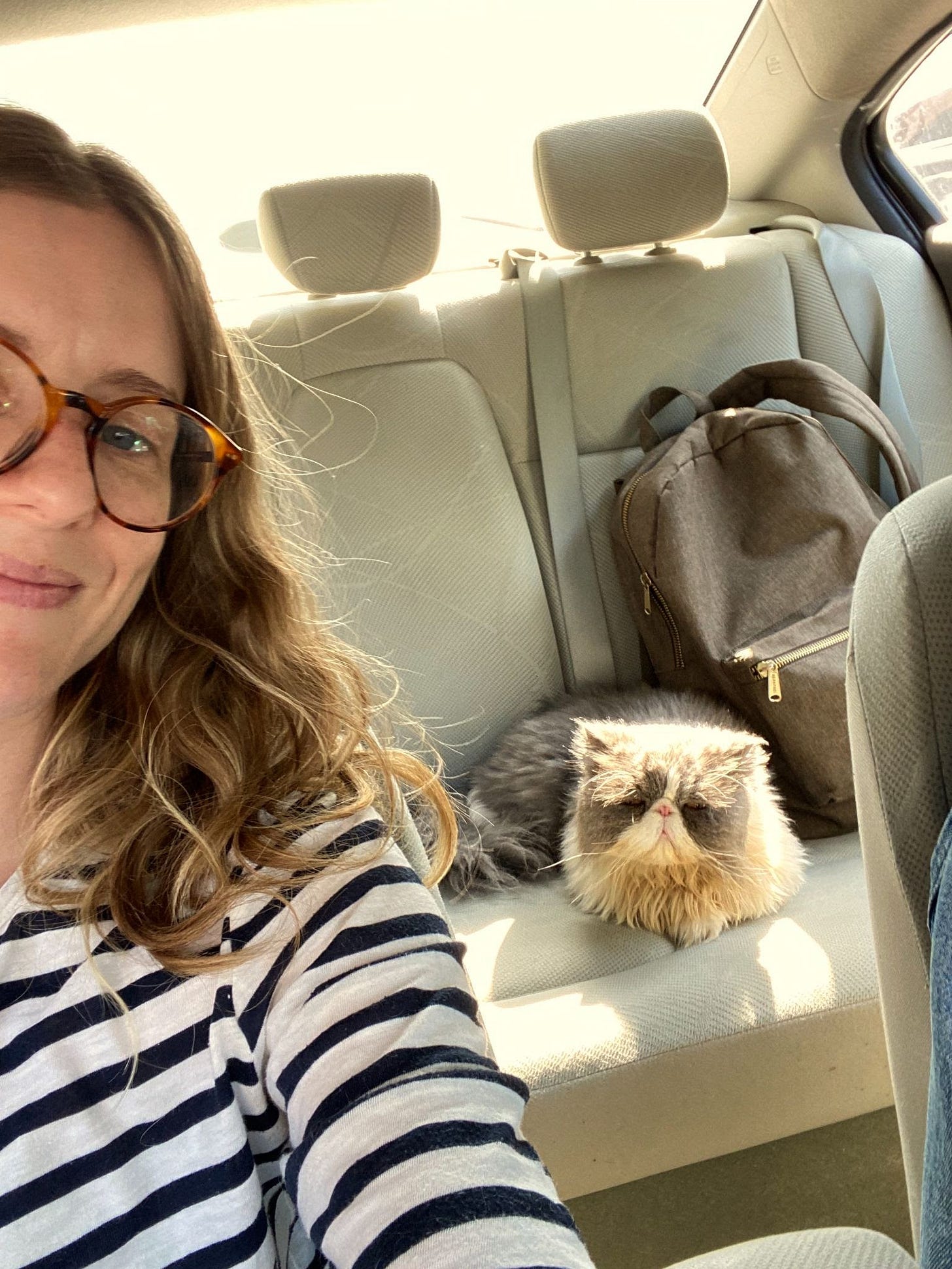#71: Always watching
Maybe Baby is a free Sunday newsletter. If you love it, consider supporting it financially. For $5/mo, you’ll gain access to my weekly recommendations, my monthly Q&A column, & my weekly podcast. Maybe Baby is reader-supported, hence the lack of ads and sponsors. Thank you!
Good morning!
Some time in July, Avi and I bought two in-home cameras so we could keep an eye on our cat if we had to leave him alone for a while. I know that sounds paranoid, and it is, but we also thought it sounded kind of cute. Our friends have a camera in their living room and sometimes, when we’re hanging out at a bar, we’ll check in on their cats for fun. There’s something about a cat sitting by itself on a couch, staring into the middle distance in an empty room, that is inherently funny. What are they thinking? When they slink off camera, where are they going?
The only problem with getting a camera for your pets is that you also, inadvertently, get a camera for yourself. Years ago, when I got one for my ex and me for the same reason (cat), he once texted me, “Once you pop,” after accidentally catching me eat Pringles alone on the couch. We laughed about that for a long time. (It’s really true about once you pop.) Weirder still was the running documentation of our lives. If we wanted to remember when we’d gotten home the night before, we’d check the camera and watch ourselves stumble in. One time I came upon footage of us getting in a fight. We sat stiffly on opposite ends of the couch. I remember thinking I looked different in the video than I imagined I did when it was happening. Did that matter? I lost the camera in the breakup, but kept the cat.
My and Avi’s cameras aren’t set up to observe us that way. One is pointed at Bug’s food bowl and another at our bedroom door, which he passes through frequently. But they do catch us from time to time. For the first week or two, sometimes I would go into the app and poke through random moments the cameras had captured. It was funny to see Bug going about his life that way; funnier, for some reason, because he thought he was alone. And whenever I’d catch myself on video—running to the bedroom for a pair of socks, opening the blinds—the way I moved was unfamiliar to me. It felt almost like looking at a stranger. I’d watch studiously, as if by inhabiting an outsider’s perspective, I might unearth some grain of truth about myself.
Technology is full of promises like that. Not just that we might gain a 360 understanding of our pets, but of ourselves. We document accordingly, obsessively. And implicit in this compulsion is the suspicion that ourselves and our lives are best understood at a remove, even a physical distance, the way someone else might experience us, rather than the way we experience ourselves. When I caught myself in the camera footage, I looked for hints as to how other people see me, believing it might lead me to see myself more clearly. I assume most people maintain some version of this fascination when they’re young, like a child seeing themselves in a photo for the first time, but I suspect we’re meant to grow out of it. And I suspect, too, that technology is hindering that process.
There is the trope, for instance, of watching your own Instagram story after you post it “to see how you come off,” or taking a video of yourself wearing an outfit to “see how it looks.” The comedian John Early has an old joke (although I can’t find it) that he knows he’s truly bored, maybe desperate, when he starts looking at his social media accounts “through the eyes” of various people in his life. In 2017, I wrote that I don’t know what I look like, but what I think I meant was that I don’t know what I look like to other people. Such a paranoia presumes that what other people think about me is both consistent and matters a lot. Or more crucially, that how other people see me is in fact who I am.
Above: a video I took of my outfit in 2016
On some level this is true. In real life especially, to witness and be witnessed, to be a “thinking, feeling, wakeful atom of life amid the constellation of other atoms,” as writer Maria Popova once put it, is crucial to our sense of identity. It implies a level of interdependence: you do not exist in a vacuum but in relation to other people and how you experience each other. But our attempts to digitize that experience—of community, of humanity—have flattened it, casting us in roles that don’t quite capture what it feels like to be alive or belong. Instead, we get spectacle. Life as performance of life. And in turn we seek a sense of self not in our communities, but by being cast in the right role.
There is a growing genre of TikTok that crystallizes this preoccupation. I just opened the app to find an example and, I kid you not, this was the first video in my feed: A beautiful girl sits on a couch, the white overlaid text reads: “New trend - this is supposed to show you how you flirt.” A Khalid song is playing. She looks off camera as if someone were there and mouths the lyrics suggestively: “You say we’re just friends but I swear when nobody’s around…” The corners of her mouth turn up, her cheeks blush. The expression is sweet and self-conscious, like she’s holding back—not from us (the spectators), but from the imagined person to whom she’s confessing feelings. She holds the expression just long enough to observe it in the self-facing camera herself when she turns back towards us, and then she breaks character and grins, big this time, pleased to learn, I guess, that she’s beautiful when she flirts.
There are countless trends like this on the app: young people pretending to read while a song plays and then looking up suddenly as if someone has called their name, the goal being—you guessed it—to learn what they look like when someone calls their name. Most often the captions are about how much better people feel about themselves after doing this. “Holy shit why isn’t everyone in love with me??” is one that sticks in my memory. Another popular iteration uses the FreezeFrame filter. Users are meant to give a “real” laugh while filming themselves and freeze the frame right when they do it so they can see what they look like when they laugh. The idea being that they will be touched by how happy and pure they look, and thus briefly cured of their self-consciousness. Seemingly, it works every time.
The primary concern of these filters, memes, and trends is to help people document aspects of themselves that are impossible to capture with your average selfie. And similarly, they are full of tricks: When the imagined stranger calls your name, the music crescendos romantically; when the video freezes on your laugh, it immediately desaturates the candid photo, making you look old-timey or famous or dead. The purported goal is to reveal how you look to other people, which we are meant to see as intrinsically important. The unspoken goal is an extension of that: to love yourself the way you love the main character in a movie. This might be kind of sweet if it wasn’t also sad: TikTok is full of self-conscious teens who want, just once, to feel like the protagonist, like something more than just themselves. The “reality” they’re after is actually a Hollywood facsimile of it. “The media represents a world that is more real than reality that we can experience,” Jean Baudrillard once said. He called it hyperreality. Life imitates art imitates life, etc. The likes and comments flood in.
What does it mean for the internet to have created a generation of not just people-watchers, but people-watched? I’ve written before about main character syndrome, and how I felt that it captured something true about postmodern interiority. But what does it actually mean for so many young people to view themselves as consumable products, or to define themselves through how they’re seen? As a 32-year-old who wouldn’t dare post on TikTok, my version of this preoccupation looks different, and may be milder, but it’s there. And it’s a burdensome existence, seeing yourself that way—like living inside the Hawthorne effect, whereby “individuals modify an aspect of their behavior in response to their awareness of being observed.” Maybe this is the logical end of mass media: a public so immersed in a consumable, aesthetic, and narrative version of reality that it becomes hard for us to imagine our lives as meaningful outside that paradigm.
There was a time during lockdown last year when I was both exhausted by Avi’s passive observation and starved for the passive observation of the public. I think both represent a core tension of identity—to experience yourself both as complete on your own and as a counterpart to something bigger. Technology exploits this need. I think many of us use it to document ourselves and our lives not out of self-love, but out of a genuine desire for self-understanding. It’s a flawed strategy, emphasizing the self as an object of interest instead of an endlessly subjective, ever-evolving, interdependent atom in a constellation of others. And maybe we find ourselves unsatisfied with these tools—scrolling and scrolling, looking and relooking—because they’re incapable of actually capturing that. They say the unobserved life isn’t worth living, but what of the over-observed one?
I notice the camera most in the middle of the night, when a blue light blinks on at the base: movement detected. When I pass it to pee, half-asleep, I’m startled to be reminded I’m alive, that I have a body, and that a lens is tracking it as it moves across the room. For a split second, I imagine what the camera is seeing: me, but from the opposite angle, a feature of the room rather than the one experiencing the room, and on some level, I’m no longer me, my consciousness briefly stolen. I’ve been thinking about that tiny moment, gone before I can really sink into it—how being watched changes an experience, changes my thoughts, and in some small way, changes me.
Pick of the week: “Dancing Through New York in a Summer of Joy and Grief,” by Carina del Valle Schorske, which is a long read but so impressive and moving in its execution. (Also this video of her dancing which put me in a good mood.)
Honorable mention: Multiple bottles of Vybes Ginger Lemonade. I’m sorry it’s called Vybes but I’m obsessed with this beverage.
Pic of the week: Bug riding solo in the backseat of the car on the way home from his heart check up. Obviously this is bad behavior but luckily for him it falls under the Make-a-Fish foundation loophole.
Here’s last week’s full “15 Things I Consumed” list.
Thanks so much for reading and have a nice Sunday!
Haley
p.s. Next week is my monthly Q&A column and podcast, Dear Baby, for paying subscribers only. If you’d like to submit a question, you can do that here. And don’t forget I’m running a sale on annual subscriptions this month!
This month a portion of subscriber proceeds will be redistributed to Center for Popular Democracy, a pro-worker, pro-immigrant advocacy group and network of over 50 community organizations working in low-income communities across the United States. They’re currently focused on the eviction crisis.
Give me feedback • Subscribe • Request a free subscription • Ask Dear Baby a question






